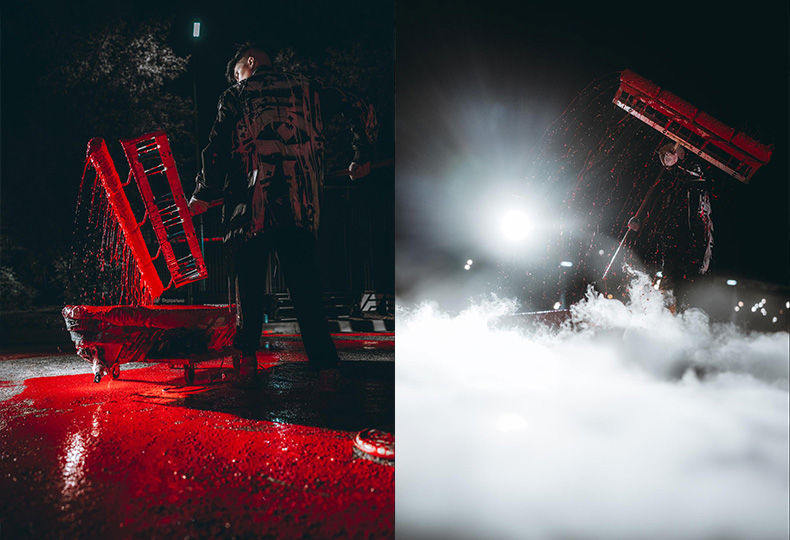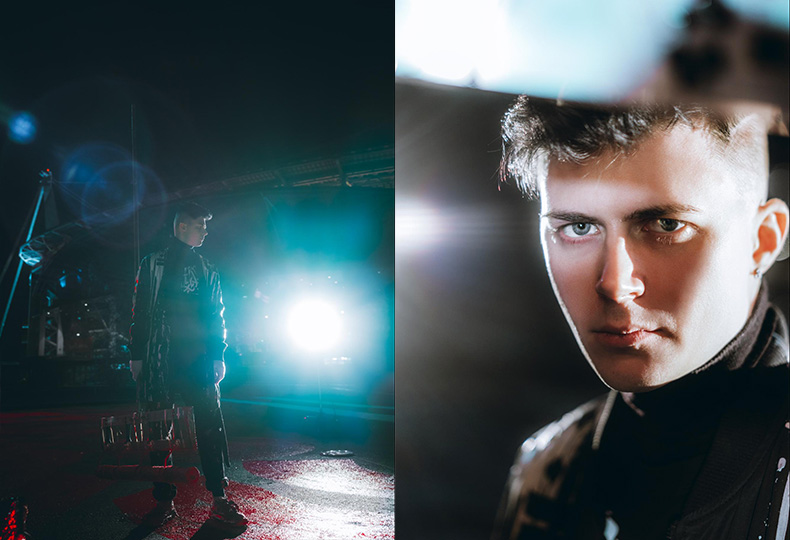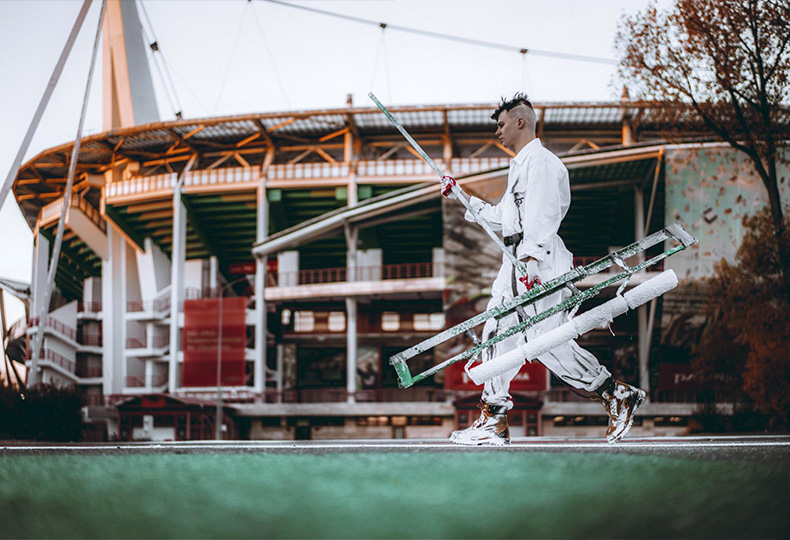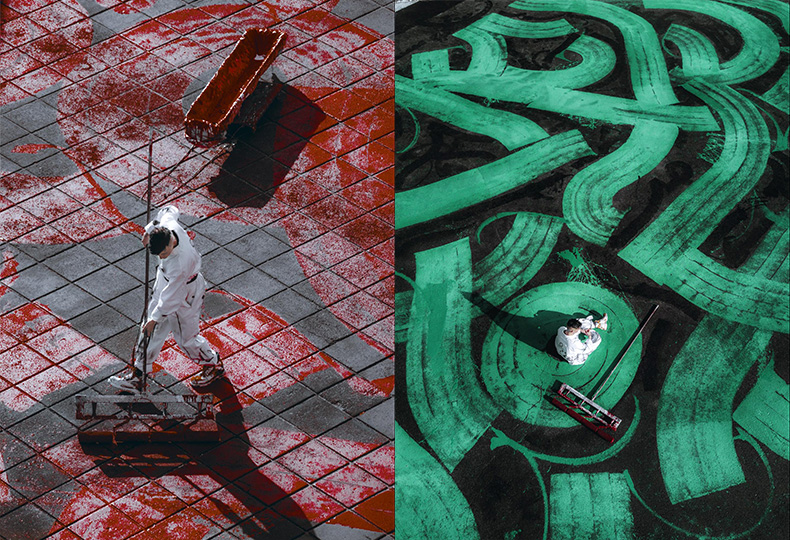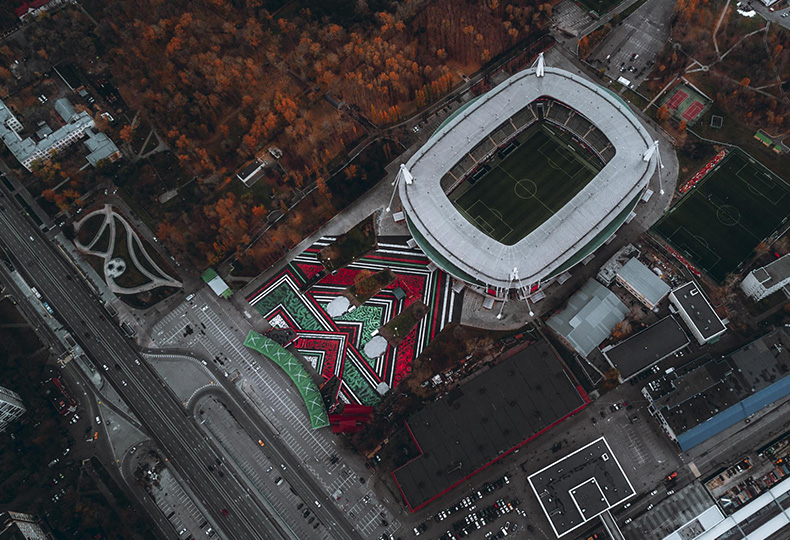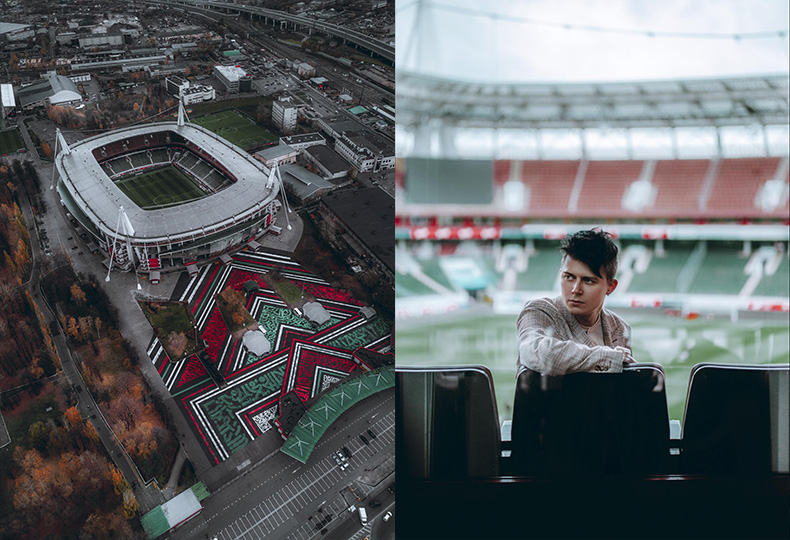
Pokras Lampas: Every Piece of Work Should Have Its Mystery
In November, artist Pokras Lampas finished a major project of the largest calligraphic painting in the world covering 11 thousand square meters of space. The record was set as part of collaboration with FC Lokomotiv, where the artist’s assignment was to paint a large square just in front of RZD Arena Stadium in Cherkizon into the team’s red and green colors. Today we invited Pokras Lampas to discuss his favorite materials, difficult surfaces and the reason why the entire world is now going crazy about Cyrillic alphabet.
Previously you had painted on female body, Lamborghinis sport car, and now you finished with entire square in front of RZD Arena stadium. Which surface is the most difficult to work with?
Actually, the most difficult surfaces are those that for some reason cannot properly accept the paint. These may be too dry or crumbly surfaces like old decayed walls faded by the sun or the surfaces covered with sand or susceptible to the weather conditions such as rain, snow, wind, et cetera. For such cases, I discovered for myself a new very efficient instrument - applicator roll. It works just fine with porous surfaces, although, makes it significantly more difficult to draw calligraphic inscriptions.
By the way, if we mentioned instruments, is it true that you have used new brand Kanye West Sneakers instead of brush? What other painting instruments you prefer?
Yes, there was a time when I experimented with very diverse range of instruments including my one of my favorite projects, where I wrote a word “HYPE” with white Yeezy Boost. In general, I use almost every instrument in the world. These are various types of painting brushes both self-made and commercial, sweepers, mops, various construction tools and materials, garden sprinklers, fire extinguishers loaded with paint, et cetera.
When you are about to paint a vast area, do you usually first develop an approximate concept of your future painting, or it is mostly improvisation? What is encrypted on the square in front of RZD Arena?
When starting almost every my project, I already know what I am going to paint, but usually have no idea how I am about to do it, so this part is always improvisation. In the art of calligraphy, it is essential to feel the instrument, and when you work on a large scale project that involves completely new and different surface, sure enough, you need some preparation like understanding the capabilities of your instrument, planning the proportions of letters and density of text, calculating how much symbols may be actually accommodated within the designated perimeter, like roof or something. Usually the process involves a certain degree of improvisation, but by the commencement of actual paintworks I generally already have a layout and a certain vision of what should be written and how exactly I should proceed with my task. As for you latter question, the square in front of the stadium bears encrypted motto of FC Lokomotiv – ‘We have our own way!’ written on several different language.
When do the football and the art have in common? Please tell me a little about the purpose of your collaboration with Lokomotiv.
The main purpose of this project is to show that modern artist may actively and successfully work with public spaces. When adopting such approach, the viewer not just walks by an art object, but becomes a part of it thanks to the scale of painting and possibility for different angles of view from the square itself to the stadium, the satellite pictures, the video content and other options available to see the finished piece of form from any perspective.
In our modern society, football has ceased to be merely a game, but turned into major event attended by huge number of people. Of course, many of them come to the stadium not only to watch a match, but also to spend some good time, enjoy themselves and get exciting emotional experience. Creation of art object within the stadium grounds helps to interpret the meaning of public space in a new way, gives visitors new impressions and context.
Why you deny that your works belong to the street art genre?
The term ‘street art’ is often associated with illegal activity, so when the people talk about coordinated and approved projects, they usually prefer to use the term ‘street wave art’. But I still believe that my works directly relate to the street art movement, and the reason why you now ask me this question is that some media released by statement for press with incorrect wording, where I am given credits for the quote: “My work is wider than street art”. In fact, I’ve never said anything like that and I consider the popularization and raising awareness about street art as one of my crucial professional goals.
In many of your art objects you use seemingly incompatible combinations of languages and fonts, so your inscriptions have to be deciphered instead of simply reading. Do you think it’s important that the viewers crack your code and understand the message, or the main thing here is the ornamental pattern itself?
I think every piece of work should have its mystery, so I intentionally leave for a viewer both easily deciphered fragments, especially those written in the Russian or the English language, and the tricky portions of painting that represent rather complicated pattern. My goal here is to make a viewer involved into process of painting consideration which is not limited to a few minutes or something, but requires deep submersion to crack the code which may last for several years depending on how often a person visits the stadium.
In your opinion, why the Cyrillic alphabet is getting so popular in the world?
I guess the Cyrillic letters have their very special, unusual appearance, where on the one hand they are somehow reminiscent of the Latin alphabet, but on the other hand they look more gnarly and weird, Taking into account the modern global trends, such image of the Cyrillic letters may be described as so called ugly look, which is quite prominent world fashion that has grown multicultural and combines various trends from the Arabic script to the futuristic Japanese hieroglyphs. Therefore, creating art objects using the Cyrillic alphabet is not just another fashion craze, but a certain contribution into development of diversity-oriented global culture.
You are often referred to as official representative of Calligraffiti movement. Does it have a lot of followers?
The Calligraffiti has many thousand fan base, and if you look through popular social networks, you may find several millions of works posted under this hashtag. The founder of this movement, Niels Shoe Meulman first introduced this term more than ten years ago, and recently he started to personally select the global representatives of this movement, so called official Calligraffiti ambassadors, the Ambassadors Extraordinary and Plenipotentiary of this newborn style. I have the honor to be one of them. I always have been proud to represent Russia at the international arena, and I am excited to realize the another world record was set in Moscow. This city and our Russian culture in general deserve much more international attention, while such large scale projects definitely influence our global image.
Is there a site that you’ve always wanted to paint but never had a good opportunity to do so?
I have many ambitious projects, but the most interesting ones are based on contrast. After setting a global record, I would rather look for new opportunities to implement by ideas from the technology perspective, like virtual or enhanced reality. These may be interaction with robots, creation of large scale projection of interactive art object. I guess it is much more interesting than beating your own record.
How has your style developed and transformed?
All my works are dedicated to the search for calligraphy of the future, something that will eventually happen to the global communication, and the changes that Russian script may undergo under influence of multicultural trends. Therefore, my main sources of inspiration are the travelling and the people I meet in my journeys, as well various institutions, museums, street art objects, artists, urban architecture and nature. Everything related to fonts, navigation, text on the road signs are the matters of principle interest to me, as well as significant influence for my calligraphy and the way I see my future pieces of work. Of course, I also draw inspiration from history of arts and fashion. In fact, I may have several sources of inspiration at the same time, like Jean-Michel Basquiat, the Soviet constructivism and fashion represented by McQueen with his brilliant performance at the Metropolitan Museum of Art, where two robots were painting model dancing in the white ballet-skirt.
Sometimes I try to limit my field of view with certain resources or specific points, so my painting go in a well-defined sequence and with a well-defined structure. It is necessary so it would be easily for a viewer to explore and accept my works. At the same time, I always have in stock many surprises and unpublished projects that are waiting for their hour.
All photos: 19tones, video: Movie Park Production.
